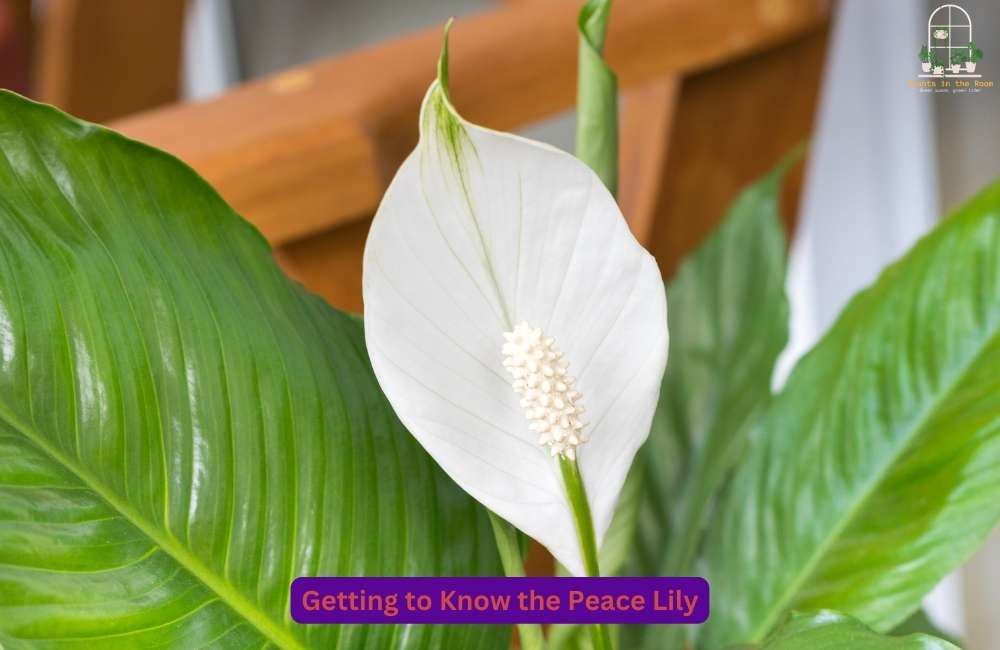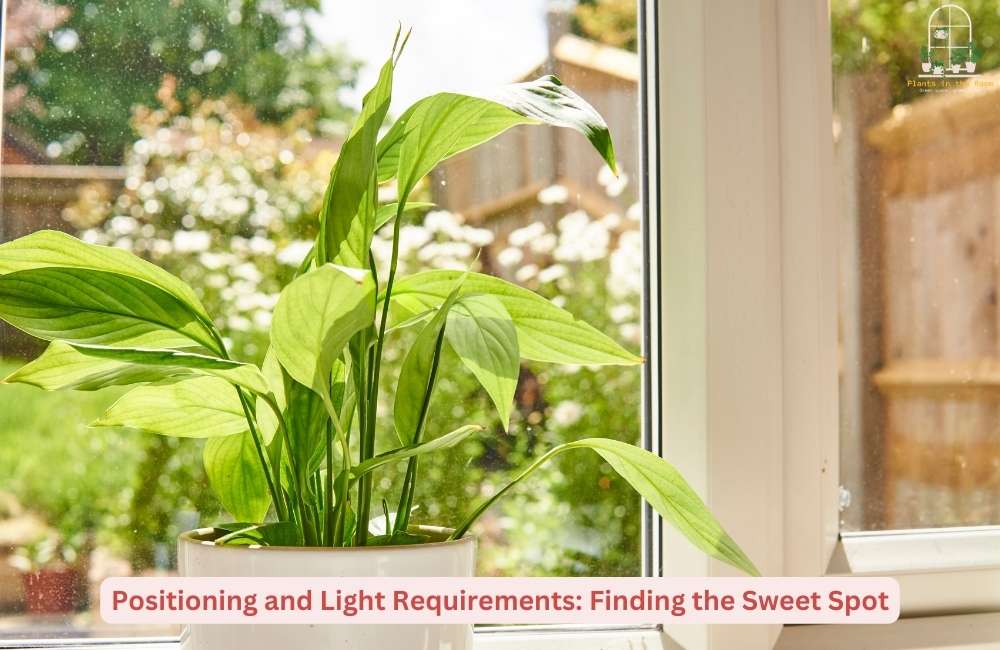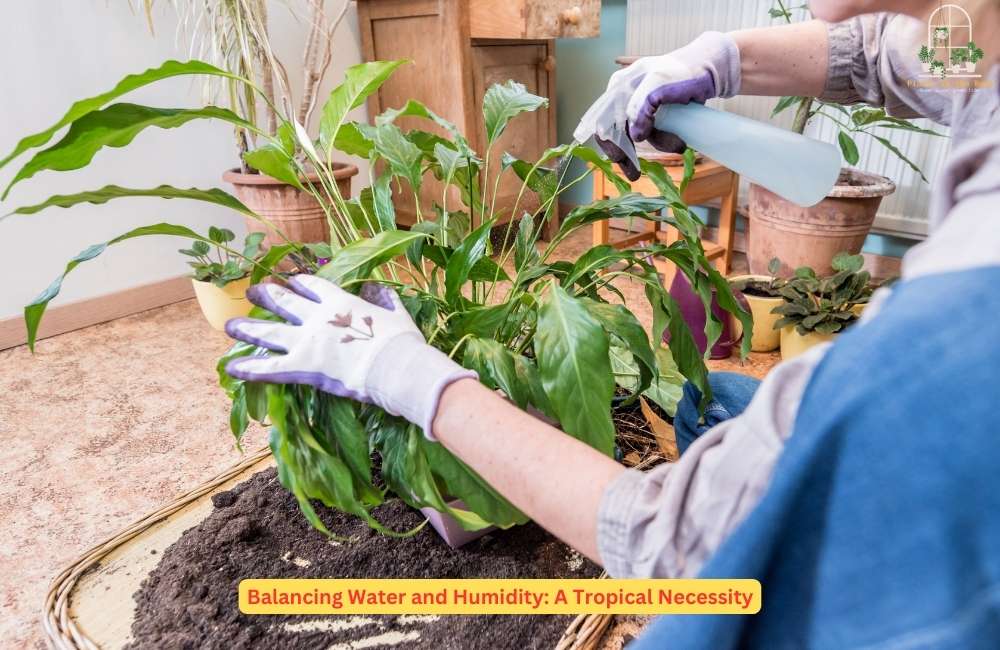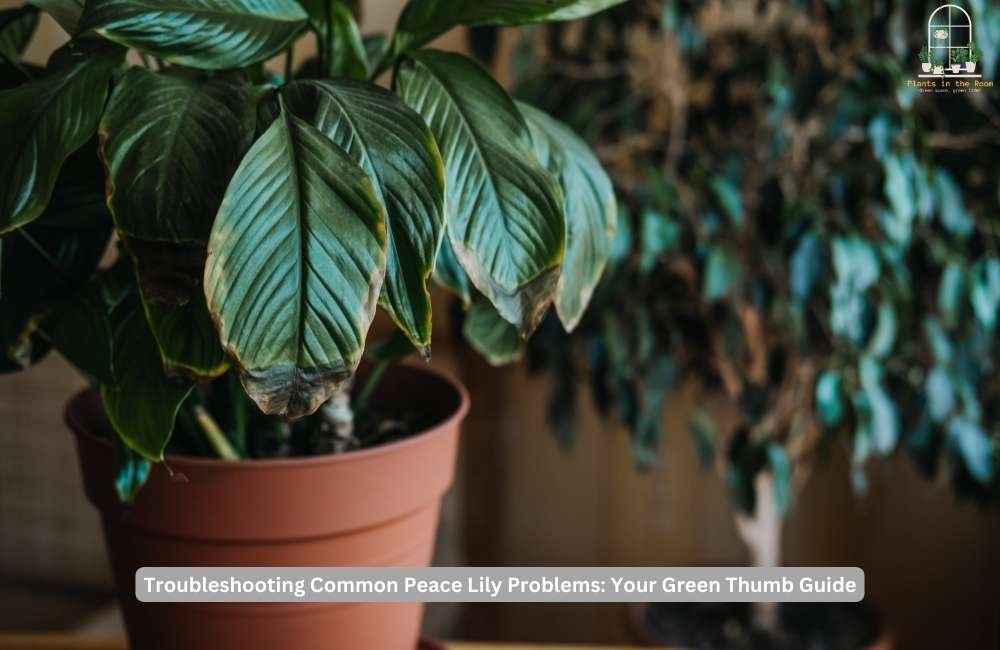This article covers the following areas –
- Getting to Know the Peace Lily
- The Essentials of Peace Lily Care
- Troubleshooting Common Peace Lily Problems: Your Green Thumb Guide
- Final Thoughts

When I initially brought home a Peace Lily, it seemed like a modest decor addition to my living room. But little did I know, this plant would become a beacon of serenity for me. Over the years, through trial and error, I have unraveled the complexities of Peace Lily care. I’m excited to share with you all my learned experiences and tips helping you cultivate tranquility in your life.
Peace Lily Care primarily provides bright, indirect light, maintains high humidity, water when the topsoil feels dry, and uses a balanced indoor plant fertilizer monthly during the growth season. Careful attention to these factors will ensure a healthy, flourishing Peace Lily.
For a more in-depth understanding of Peace Lily Care, continue reading. We delve deeper into topics like positioning, balancing water and humidity, fertilization, repotting, and troubleshooting common Peace Lily problems. Gain insights from personal experiences and practical tips that will help you cultivate a vibrant Peace Lily.
Getting to Know the Peace Lily

Embarking on my Peace Lily journey, I found myself filled with curiosity. I wanted to understand more about this striking plant that had taken up residence in my home. The Peace Lily, scientifically known as Spathiphyllum, captivated me with its simplicity and elegance, not to mention the soft, serene aura it radiated. Native to the rich, moist, and shaded areas of tropical rainforests in the Americas and southeastern Asia, this plant brought a touch of exotic wilderness into my indoor space.
However, the beauty of this plant goes beyond its white, sail-like flowers and lush green leaves. As I delved deeper into understanding the Peace Lily, I realized that it came with many unique features that made it more than just an ornamental addition to my home.
The Peace Lily as an Indoor Air Purifier
One of the unique features that fascinated me about the Peace Lily is its inherent ability to purify air. This attribute sets it apart from many other houseplants. The Peace Lily is one of the few plants that can filter and neutralize toxins present in our environment, making our indoor air cleaner and healthier to breathe.
How Does Peace Lily Purify Air?
As an air-purifying plant, the Peace Lily has shown efficacy in absorbing indoor pollutants such as benzene, formaldehyde, and carbon monoxide, toxins commonly released by household goods and furnishings. The plant’s stomata, tiny openings on the surface of the leaves, take in these harmful compounds, which then get broken down in the plant’s tissue and soil.
I was particularly impressed by a study by NASA, which included the Peace Lily in its list of top air-purifying plants. Knowing I have a natural air purifier in my home has made me appreciate the Peace Lily even more.
The Resilient Nature of the Peace Lily
One of the things I admire most about the Peace Lily is its resilience. While it thrives in a lovingly cared for environment, it can also withstand periods of neglect.
The Forgiving Peace Lily: A Survivor
If you’re someone like me who occasionally forgets to water your plants or is away from home often, you’ll appreciate the Peace Lily’s forgiving nature. Even if neglected for a few days, the Peace Lily can recover rapidly with adequate care and attention.
The plant communicates its needs quite visibly. For instance, if it’s thirsty, the leaves will start to droop, signaling a need for water. Once watered, you’ll see it perk up within a few hours—a wonderful demonstration of its hardiness and adaptability. However, not making this a habit is essential since consistent underwatering can stress the plant and inhibit its growth and flowering.
In my experience, the Peace Lily has been an incredible indoor companion. Its dual role as an attractive ornamental plant and an air purifier makes it a fantastic addition to any home. But above all, it’s the Peace Lily’s resilience and adaptability that make it such a beloved houseplant, and these are the qualities that I’ve found most rewarding on my journey of understanding this tropical marvel.
The Essentials of Peace Lily Care
The allure of a Peace Lily lies not just in its beauty but also in its minimalistic care demands. As a Peace Lily parent, I’ve found that this plant, with its glossy green leaves and charming white blooms, adds a vibrant touch to my indoor space with relatively little effort.
Still, nurturing a Peace Lily is not entirely without its subtleties. It’s like engaging in a gentle dance, where understanding your partner’s (in this case, the Peace Lily’s) needs and signals can lead to a harmonious performance.
In this section, I’ll share the key aspects of Peace Lily care I’ve discovered over the years, including the ideal positioning, balancing water and humidity, and the right fertilization and repotting practices. These aspects intertwine to ensure the health and beauty of your Peace Lily.
1. Positioning and Light Requirements: Finding the Sweet Spot

When I first welcomed a Peace Lily into my home, I didn’t fully comprehend the importance of its positioning and light requirements. I had to understand this tropical plant’s specific needs to help it thrive. As it turns out, location and lighting are two key factors in Peace Lily care that can significantly impact its health and growth.
The Peace Lily originates from the rainforests of South America and Southeast Asia. These are environments where the sun’s rays seep through a thick canopy of leaves, providing diffused light to the plants below. This means that while the Peace Lily needs light to thrive, it doesn’t require harsh, direct sunlight.
At first, I assumed that placing my Peace Lily directly under the sun would be beneficial. Like many other plants, I thought it would relish the abundance of light. However, my assumption proved to be misguided. I began noticing the leaves turning yellow, and the normally perky white flowers started to wilt and brown at the edges. This was my first introduction to the subtle art of Peace Lily care – the plant was signaling to me that it was getting too much direct sunlight.
Taking this as a learning experience, I began experimenting with different spots in my home. I was looking for a location that provided bright but indirect light. I found the perfect spot near a north-facing window, where my Peace Lily could enjoy a generous amount of light without the harshness of direct sun rays.
I closely monitored Peace Lily’s response to its new environment to ensure I had found the right balance. The signs of distress, such as yellowing leaves, gradually disappeared. The plant’s foliage returned to its lush, dark green color, and the flowers regained their pristine white hue and elegant form.
Over time, I’ve discovered a few more tips and tricks to ensure my Peace Lily gets the right amount of light:
- Use sheer curtains: If the plant is near a window that gets direct sunlight, use sheer curtains to diffuse the light and protect the Peace Lily from sunburning.
- Rotate the plant: I occasionally rotate the pot to ensure all parts of the Peace Lily get equal exposure to light. This promotes even growth and prevents the plant from leaning towards the light source.
- Watch out for signs: If the Peace Lily isn’t getting enough light, its leaves may become a lighter shade of green, and it may not flower well. On the other hand, too much light can cause the leaves to turn yellow or develop brown, scorched spots.
Understanding the Peace Lily’s light requirements and adjusting its location has significantly improved my plant’s health and appearance. My Peace Lily now stands as a testament to the beauty of nature in my living room, its glossy leaves and graceful flowers radiating a serene elegance.
2. Balancing Water and Humidity: A Tropical Necessity

As a plant parent to a Peace Lily, it’s easy to appreciate the beauty of its glossy green leaves and stunning white flowers. However, to fully nurture this plant, I had to understand and meet its particular need for moisture and humidity, which are critical factors contributing to its overall well-being.
The Peace Lily naturally thrives in a moist environment from tropical rainforests. Rainforests are renowned for their high humidity, frequent rains, and rich, well-drained soil. As a result, caring for a Peace Lily involves replicating these conditions in a domestic setting. But it’s not just about watering the plant; it’s also about maintaining the right balance between hydration and humidity. Let me share my journey in achieving this balance.
Watering your Peace Lily Right: The Art of Moderation
Watering plants might seem like the simplest task, but it’s a whole different story regarding Peace Lilies. The plant is sensitive to both overwatering and underwatering. While it loves moisture, excess water can lead to root rot, eventually killing the plant.
The key, I found, was to observe the plant and the soil closely. I started watering my Peace Lily only when the top inch of the soil felt dry to the touch. This gave the plant enough water to stay hydrated without risking waterlogging. I also made sure to use a pot with good drainage to prevent water from pooling at the bottom.
Another critical aspect I discovered was the temperature of the water. The shock from cold water can stress the plant and cause the leaf tips to brown. To avoid this, I began using lukewarm water, which the plant seemed to appreciate.
Humidity for a Happy Peace Lily: Mimicking a Tropical Climate
While watering is essential for the Peace Lily, it’s not enough to ensure optimum health. These plants also crave high humidity levels, similar to their native rainforest habitats.
Initially, I was uncertain about maintaining a high humidity level, especially during the dry winter months. After trying out different methods, I found two that worked exceptionally well:
- Misting the leaves: Using a simple spray bottle, I mist the leaves of the Peace Lily every other day. The water droplets on the leaf surface increase the local humidity, providing a refreshing and conducive environment for the plant.
- Using a humidifier: I turn on a humidifier near the plant during dry seasons or if the air conditioning is on. This maintains the moisture levels in the air, helping the Peace Lily feel right at home.
It’s important to note that while the Peace Lily loves humidity, it doesn’t appreciate wet leaves as it could lead to leaf spot disease. So, whenever I mist the plant, I do so lightly and in the morning to allow the leaves to dry throughout the day.
I’ve understood and created the perfect moisture and humidity balance for my Peace Lily through trial and error. It’s a dance between not letting the plant dry out and not letting it sit in too much water. And once you get the rhythm right, the result is a thriving, happy Peace Lily that lights up your space with its tropical charm.
3. Fertilization and Repotting Practices: A Nourishing Routine

Caring for a Peace Lily isn’t just about watering, lighting, and humidity. I’ve found that it’s also about ensuring the plant receives the right nutrition and has ample space to grow. To help my Peace Lily thrive and bloom, I learned to incorporate fertilization and repotting into my plant care routine. Here’s how I approached these two important aspects:
Fertilizing the Peace Lily: The Gift of Nutrition
In the early days of my Peace Lily care journey, I assumed that watering and placing the plant in a suitable light would be enough. However, as weeks turned into months, I realized that the growth of my Peace Lily seemed stunted, and it wasn’t producing as many flowers as before. After some research, I discovered that my Peace Lily needed extra nutrients.
Like other houseplants, Peace Lilies can exhaust the nutrients in their potting soil over time. I began feeding my Peace Lily with a balanced indoor plant fertilizer to compensate for this.
Here are a few things I learned about fertilizing Peace Lilies:
- The right time: Peace Lilies mainly grow during the spring and summer. So, I started applying fertilizer once a month during these growing seasons. This helped my plant produce a wealth of lush leaves and beautiful blooms.
- The right amount: Peace Lilies are sensitive to over-fertilization. Using too much fertilizer can result in burnt leaf tips or yellowing leaves. I found that a light touch was the best approach.
- The right type: I opted for a balanced houseplant fertilizer (look for numbers like 20-20-20 on the packaging, which represents the proportions of nitrogen, phosphorus, and potassium).
Repotting the Peace Lily: Room to Grow
Repotting is another significant aspect of Peace Lily care. Over time, the Peace Lily can outgrow its pot, and the soil can become depleted of nutrients. Repotting addresses both these issues, providing fresh soil and more space for the plant’s roots.
I usually repot my Peace Lily every 1-2 years. The process can be intimidating, especially the first time, but the plant’s response makes it all worthwhile. Here’s my repotting routine:
- Best time to repot: I found that early spring is the best time to repot Peace Lilies. This is when the plant is coming out of its winter dormancy and preparing to enter the growing season.
- Choosing the right pot: When it comes to choosing a new pot, size matters. A pot too large can lead to overwatering problems, while a small pot can constrict the Peace Lily’s growth. I opt for a pot that’s about 2 inches larger in diameter than the old one.
- Refreshing the soil: I use fresh potting soil for each repotting, ensuring my Peace Lily has a new supply of nutrients.
- Aftercare: Following repotting, I water the plant thoroughly and place it in a shady area for a few days to recover.
Learning how to fertilize and repot my Peace Lily properly took some trial and error, but the results were definitely worth it. My Peace Lily now grows more robustly and blooms more prolifically than ever. It not only purifies my indoor air but also adds a touch of tranquility and elegance to my home. Through understanding and fulfilling its needs, I’ve found that Peace Lily care is indeed a rewarding journey.
Troubleshooting Common Peace Lily Problems: Your Green Thumb Guide

In my experience, taking care of a Peace Lily isn’t always smooth sailing. Just like us, these plants have their good and bad days. My Peace Lily sometimes showed signs of distress, leaving me worried and baffled. However, I soon learned these were common issues many Peace Lily owners face. The key was understanding what my plant was trying to tell me and responding accordingly. Here are some issues I encountered, along with the solutions I found:
1. Yellow Leaves: Overwatering Alert
One day, I noticed that the vibrant green leaves of my Peace Lily had started turning yellow. Seeing the plant I had nurtured with such care showed signs of sickness was disheartening. After some frantic searching and reading, I discovered this was a classic sign of overwatering.
In the tropical rainforest, a Peace Lily would experience heavy rainfall followed by periods of relatively dry soil. I frequently water my Peace Lily, not allowing the soil to dry out between waterings. As a result, the roots were getting waterlogged and rotting, leading to yellow leaves.
To rectify this, I reduced the watering frequency and only water when the top inch of the soil had dried out. I also ensured my pot had sufficient drainage holes at the bottom, allowing any excess water to escape.
Remember, it’s better to under-water a Peace Lily than to overwater. If you notice yellow leaves, check your watering routine – your plant might be asking for less water!
2. Brown Leaf Tips: A Cry for Humidity
Brown leaf tips on a Peace Lily often indicate that the air around the plant is too dry. Remember, Peace Lilies come from a tropical environment where the air is humid.
When I first spotted brown tips on my Peace Lily leaves, I initially thought it was due to a watering issue. However, upon closer examination and research, I realized the problem was low humidity.
I misted the leaves with water every morning using a spray bottle to increase the humidity. I also considered using a humidifier near the plant for a hands-off approach. These changes increased the moisture in the air, replicating the humid environment that Peace Lilies love.
Remember, brown tips are not a watering issue but a humidity one. Increase the humidity around your Peace Lily, and those brown leaf tips should start to reduce.
3. Absence of Blooms: The Light Dilemma
A Peace Lily without its beautiful white blooms can seem quite dull. I remember when my Peace Lily stopped blooming – the lush green foliage was there, but the lovely white flowers were absent.
After digging, I learned this was usually due to insufficient light. While it’s true that Peace Lilies can tolerate low light, they won’t produce flowers unless they receive bright, indirect light.
I decided to move my Peace Lily to a brighter spot where it would get plenty of indirect sunlight. After a few weeks, I was thrilled to see the new blooms starting to form.
Remember, if your Peace Lily isn’t blooming, it might ask for more light. Consider shifting it to a brighter location, but remember to keep it away from direct sunlight to avoid scorching the leaves.
In my Peace Lily care journey, I’ve learned that each problem has a solution. The plant tells us what it needs; our job is to understand its signals and provide the right care. Doing so can ensure our Peace Lilies continue to thrive and bloom, bringing tranquility and beauty into our homes.
Final Thoughts
Peace Lilies are elegant and resilient plants that can purify the air and add a touch of serenity to your indoor space. Understanding the plant’s requirements and striking the right balance in light, water, humidity, and feeding can make Peace Lily care a rewarding experience.
The beauty of this plant, coupled with its hardy nature, makes it a popular choice for both beginner and experienced gardeners. As with any plant, patience, observation, and consistent care go a long way in cultivating a thriving Peace Lily. This guide, backed by personal experiences and knowledge, aims to make your journey in Peace Lily care a successful and enjoyable one.






